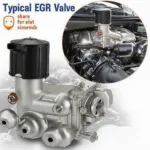Understanding the OBD2 drive cycle is crucial for anyone who owns a car. Whether you’re a professional mechanic or a DIY enthusiast, knowing how to complete an OBD2 drive cycle can help you diagnose vehicle issues, ensure your car is running efficiently, and even prepare for emissions testing. This guide will delve into everything you need to know about the “obd2 drive cycle book,” exploring the various drive cycles, their importance, and how to perform them correctly.
What is an OBD2 Drive Cycle?
An OBD2 drive cycle is a specific series of driving conditions designed to prepare your vehicle’s onboard diagnostic system (OBD2) for emissions testing. It allows the system to run all of its monitors and detect potential issues related to emissions. Completing a drive cycle ensures all relevant diagnostic trouble codes (DTCs) are set, enabling accurate diagnostics and repairs. Think of it as a standardized test for your car’s emissions system.
Why is the OBD2 Drive Cycle Important?
Completing an OBD2 drive cycle is essential for several reasons:
- Accurate Diagnostics: A completed drive cycle ensures all diagnostic monitors have run, allowing the OBD2 scanner to identify any potential problems. Incomplete cycles can lead to missed DTCs and inaccurate diagnoses.
- Emissions Testing Readiness: Many states require vehicles to pass an OBD2 readiness check as part of their emissions testing. Failing to complete a drive cycle can result in failing the emissions test, even if there’s nothing wrong with your vehicle.
- Post-Repair Verification: After repairing an emissions-related issue, completing a drive cycle verifies the fix and ensures all monitors are functioning correctly.
- Improved Fuel Efficiency: Identifying and addressing emissions-related problems can contribute to improved fuel efficiency and overall vehicle performance.
Different Types of OBD2 Drive Cycles
There are various types of OBD2 drive cycles, each designed for specific vehicle makes and models. Some common types include:
- Generic Drive Cycle: A general drive cycle that can be used for many vehicles. However, it might not be as effective as manufacturer-specific cycles.
- Manufacturer-Specific Drive Cycles: These cycles are tailored to specific vehicle makes and models, providing the most accurate results for diagnostics and emissions testing.
- Cold Start Drive Cycle: This cycle begins with a cold engine, allowing the OBD2 system to monitor emissions components during warm-up.
- Warm Start Drive Cycle: This cycle starts with a warm engine and is often shorter than a cold start cycle.
Where to Find OBD2 Drive Cycle Information (“OBD2 Drive Cycle Book”)
Finding the correct drive cycle for your vehicle is crucial. While a physical “obd2 drive cycle book” might not exist, the information is readily available:
- Repair Manuals: Your vehicle’s repair manual is the best source for manufacturer-specific drive cycle information.
- Online Resources: Websites like OBDFree offer detailed information on various drive cycles, including manufacturer-specific procedures.
- OBD2 Scanners: Some advanced OBD2 scanners provide access to drive cycle information and can even guide you through the process.
How to Perform a Generic OBD2 Drive Cycle
While manufacturer-specific cycles are preferred, here’s a general overview of a generic OBD2 drive cycle:
- Cold Start: Start the engine after it has been sitting for at least eight hours.
- Idle: Let the engine idle for two minutes.
- Acceleration and Cruise: Accelerate smoothly to 55 mph and maintain this speed for three minutes.
- Deceleration: Decelerate gradually without braking (if possible) to 20 mph.
- Acceleration and Cruise: Accelerate back to 55 mph and maintain this speed for five minutes.
- Idle: Let the engine idle for five minutes.
Remember, this is a general guideline, and manufacturer-specific cycles may differ significantly.
“Following the correct drive cycle is paramount for accurate diagnostics,” says John Miller, ASE Certified Master Technician. “Using a generic cycle might not trigger all the necessary monitors, potentially leading to misdiagnosis.”
Common Mistakes to Avoid
- Not Completing the Full Cycle: Interrupting the drive cycle can reset the monitors and require you to start over.
- Using the Wrong Drive Cycle: Using a generic cycle when a manufacturer-specific cycle is required can lead to inaccurate results.
- Ignoring Dashboard Warning Lights: If any warning lights illuminate during the drive cycle, address them promptly before continuing.
Conclusion
The “obd2 drive cycle book,” while not a physical book, represents the crucial knowledge required for proper vehicle diagnostics and emissions testing. Understanding and performing the correct OBD2 drive cycle is essential for ensuring accurate results and maintaining your vehicle’s optimal performance. By following the guidelines outlined in this article and consulting manufacturer-specific resources, you can confidently tackle any diagnostic challenge and keep your car running smoothly.
FAQ
- What is an OBD2 drive cycle? A specific series of driving conditions to prepare the vehicle’s OBD2 system for emissions testing.
- Why is it important? It ensures accurate diagnostics and emissions testing readiness.
- Where can I find the correct drive cycle for my car? Repair manuals, online resources, and some OBD2 scanners.
- What is a generic drive cycle? A general drive cycle that may not be as effective as manufacturer-specific ones.
- What should I do if a warning light comes on during the drive cycle? Address the issue promptly before continuing.
- How long does a typical drive cycle take? It can vary, but generally between 20-30 minutes.
- Can I interrupt the drive cycle? No, interrupting it can reset the monitors.
“Remember, investing time in understanding your vehicle’s specific OBD2 drive cycle can save you time and money in the long run,” advises Sarah Johnson, Automotive Engineer at GreenTech Auto Solutions.
You might also be interested in these articles: “Understanding OBD2 Codes” and “Choosing the Right OBD2 Scanner.”
Need help with OBD2 scanners or diagnostics? Contact us via WhatsApp: +1(641)206-8880, Email: [email protected] or visit us at 789 Elm Street, San Francisco, CA 94102, USA. We offer 24/7 customer support.


